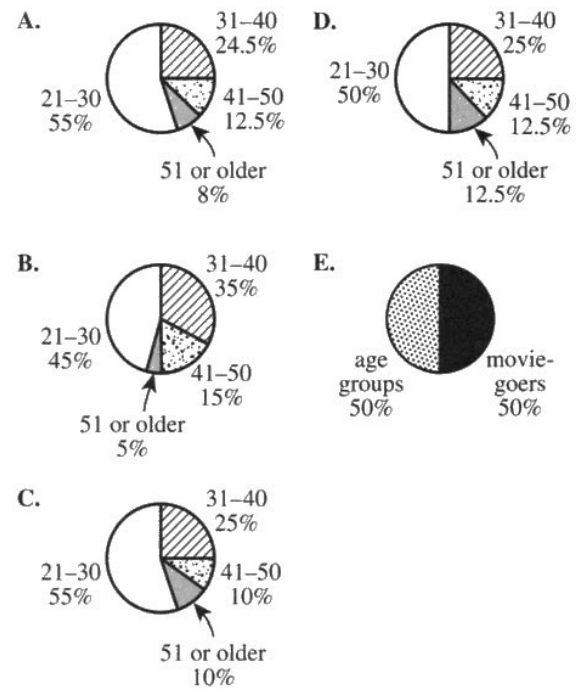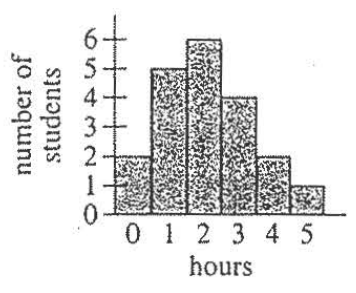(9.) One of the following circle graphs represents the proportion by age group of the adults surveyed.
Which one?

We have about a minute to solve this question.
So, we shall find the sectorial angle for the first age group and then use the process of elimination to identify our answer
If necessary, we shall find the sectorial angle for the second age group and also eliminate options
We shall repeat this process until we get our answer
$ Sectorial\;\;\angle\;\;for\;\;each\;\;age\;\;group = \dfrac{frequency\;\;of\;\;the\;\;age\;\;group}{\Sigma f} * 100 \\[5ex] \underline{21-30\;\;Age\;\;Group} \\[3ex] Sectorial\;\;\angle = \dfrac{2750}{5000} * 100 \\[5ex] = 55\% \\[3ex] $ Eliminate Options B., D., and E.
Let us calculate the sectorial angle for the second age group
$ \underline{31-40\;\;Age\;\;Group} \\[3ex] Sectorial\;\;\angle = \dfrac{1225}{5000} * 100 \\[5ex] = 24.5\% \\[3ex] $ Eliminate Option C.
Option A. is the correct answer.
For those who just want to complete the rest of the age groups
$ \underline{41-50\;\;Age\;\;Group} \\[3ex] Sectorial\;\;\angle = \dfrac{625}{5000} * 100 \\[5ex] = 12.5\% \\[3ex] \underline{51\;\;or\;\;Older\;\;Age\;\;Group} \\[3ex] Sectorial\;\;\angle = \dfrac{400}{5000} * 100 \\[5ex] = 8\% \\[5ex] \underline{Check} \\[3ex] \Sigma Sectorial\;\; \angle = 55 + 24.5 + 12.5 + 8 = 100\% $
Which one?

We have about a minute to solve this question.
So, we shall find the sectorial angle for the first age group and then use the process of elimination to identify our answer
If necessary, we shall find the sectorial angle for the second age group and also eliminate options
We shall repeat this process until we get our answer
$ Sectorial\;\;\angle\;\;for\;\;each\;\;age\;\;group = \dfrac{frequency\;\;of\;\;the\;\;age\;\;group}{\Sigma f} * 100 \\[5ex] \underline{21-30\;\;Age\;\;Group} \\[3ex] Sectorial\;\;\angle = \dfrac{2750}{5000} * 100 \\[5ex] = 55\% \\[3ex] $ Eliminate Options B., D., and E.
Let us calculate the sectorial angle for the second age group
$ \underline{31-40\;\;Age\;\;Group} \\[3ex] Sectorial\;\;\angle = \dfrac{1225}{5000} * 100 \\[5ex] = 24.5\% \\[3ex] $ Eliminate Option C.
Option A. is the correct answer.
For those who just want to complete the rest of the age groups
$ \underline{41-50\;\;Age\;\;Group} \\[3ex] Sectorial\;\;\angle = \dfrac{625}{5000} * 100 \\[5ex] = 12.5\% \\[3ex] \underline{51\;\;or\;\;Older\;\;Age\;\;Group} \\[3ex] Sectorial\;\;\angle = \dfrac{400}{5000} * 100 \\[5ex] = 8\% \\[5ex] \underline{Check} \\[3ex] \Sigma Sectorial\;\; \angle = 55 + 24.5 + 12.5 + 8 = 100\% $
(10.) GCSE A set of data has
mean = 30
median = 25
standard deviation = 4
Circle the value of the skew for the data.
$ Use\;\;skew = \dfrac{3(mean - median)}{standard\;\;deviation} \\[5ex] $ -11.25 1.25 3.75 16.25
$ mean = 30 \\[3ex] median = 25 \\[3ex] standard\;\;deviation = 4 \\[3ex] skew \\[3ex] = \dfrac{3(mean - median)}{standard\;\;deviation} \\[5ex] = \dfrac{3(30 - 25)}{4} \\[5ex] = \dfrac{3(5)}{4} \\[5ex] = \dfrac{15}{4} \\[5ex] = 3.75 $
mean = 30
median = 25
standard deviation = 4
Circle the value of the skew for the data.
$ Use\;\;skew = \dfrac{3(mean - median)}{standard\;\;deviation} \\[5ex] $ -11.25 1.25 3.75 16.25
$ mean = 30 \\[3ex] median = 25 \\[3ex] standard\;\;deviation = 4 \\[3ex] skew \\[3ex] = \dfrac{3(mean - median)}{standard\;\;deviation} \\[5ex] = \dfrac{3(30 - 25)}{4} \\[5ex] = \dfrac{3(5)}{4} \\[5ex] = \dfrac{15}{4} \\[5ex] = 3.75 $
